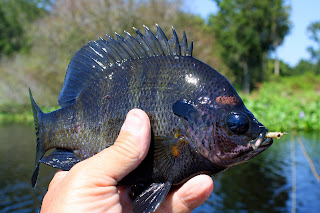 |
| Jonathan Allred said Texas bluegill love the Mighty Myakka Minnow |
I knew I'd come up with a great fly. I had no idea it would work so well across the country.
Jonathan Allred, a client of mine from near Dallas, Texas, emailed me some photos of some hefty bluegill he caught using the Myakka Minnow.
I'd given Allred a couple of Myakka Minnows during his last trip here. I wondered if he'd had the chance to use them?
He did well. And, he said, "with a red tail, they'd be perfect for grayling in Alaska."
Allred isn't the first to tout the Myakka Minnow. I received an email from Steve Piper of San Diego, Calif.
"I saw your FAOL article and tied up a couple on Friday night.
"We were fishing Diamond Valley Lake in SoCal and stripers and largemouth were busting threadfin shad. They were so focused on the shad that they would not take our flies. Sounded very much like the situation you described with fish and minnows.
"Most of the morning, we had to let the flies drop way down in the water column below the boils -- to 20 feet or so -- to catch a few.
"However, during some long lulls, I tried the Myakka Minnow -- shad variation -- white marabou
tail, pearl diamond braid body with felt tip cool gray back, and UV knot sense to seal the body, no weight. It seemed like everytime I cast it, it turned up a fish -- all very small -- including 8-10" largemouth and a plump bluegill.
"We went back to fishing big flies deep, but at the very end of our session, I tried the Myakka again to see if it really was "magic" -- yep, nailed another small bass to end the day.
"We were laughin'..."
"Got a Myakka for the big models? That was amazing."
Glad you had a wonderful experience with this amazing fly. And, yes, I do have a Myakka Minnow for larger fish.
The beauty of the fly is that it can be tied on any size hook to meet your needs. A couple of years ago, Capt. Rick Grassett of the Snook Fin-Addict in Sarasota told me that he has some large tarpon eating glass minnows, but couldn't get them to hit conventional tarpon flies. I tied him up a couple of Myakka Minnows on 3/0 hooks and gave them to him.
Couple of days later, he called to tell me that he'd finally jumped a couple of those tarpon.
"All they wanted was the Myakka Minnow," Grassett said.
Another angler in North Carolina emailed me to order a dozen Myakka Minnows. I tied them and sent them to him.
He said they were heading to the Florida Everglades and had heard the minnow worked well there. But I didn't hear from him for six months.
Finally, I received an email, detailing his trip. He told me they didn't catch a fish at the first stop, so they put the boat on trailer and headed for another spot.
Same story.
"Finally, I remembered I had the Myakka Minnows you tied," he said. "I put one on and started catching fish. It's the only fly they'd hit.
"The Myakka Minnow said the day!"
On another occasion, Capt. Al White of Boca on the Fly and I took famed fly tyer Ward Bean to the Everglades. It was the wrong time of year, but Bean, who resided in Iowa, was in town and wanted to go.
Bean ties some elaborate hair bugs. They're so beautiful that I consider them works of art.
If was last June, the water was up and it was hot. I was no time to be in the 'Glades. I usually fish there late November through April (the dry season).
Fish was slow as expected. Bean caught a couple of fish on his hair bugs and other flies. I totaled 40 assorted fish (oscar, Mayan cichlid, bass, bluegill, stumpknocker and peacock bass) on the Myakka Minnow. I offered Bean a couple of minnows, but he wanted to stick with his flies.
Although I'm not a commercial fly tyer, I do take orders for the Myakka Minnow. Because of the epoxy work involved, I sell them only by the dozen. Cost is $45 per dozen (plus shipping).
If you want to try this amazing fly, you can email me at steve@kayakfishingsarasota.com or call me at (941) 284-3406.














